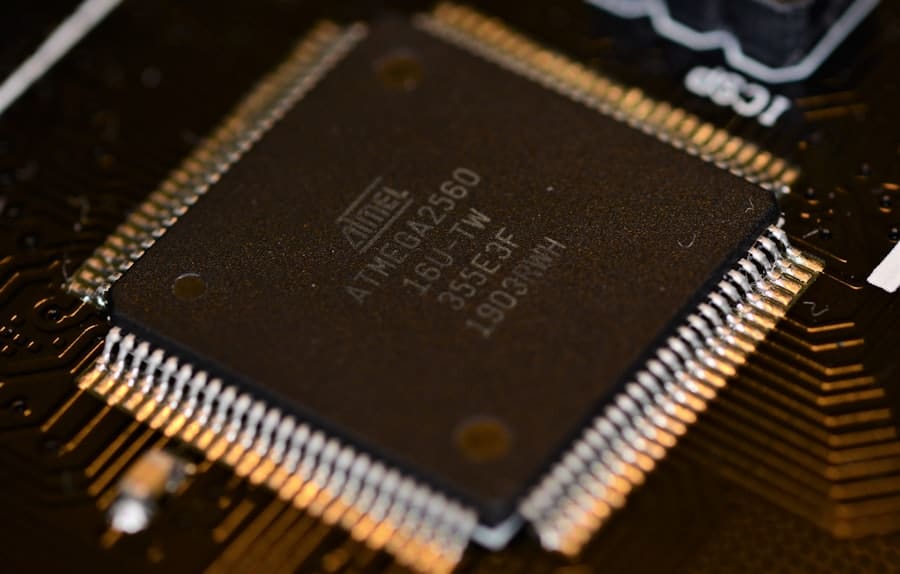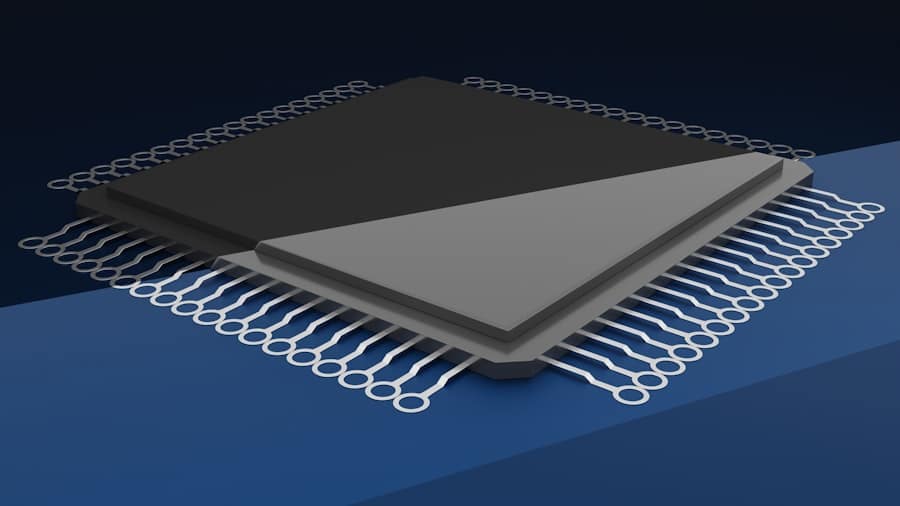Neuromorphic processors represent a groundbreaking approach to computing, designed to emulate the neural architecture of the human brain. Unlike traditional processors that operate on a binary system of ones and zeros, neuromorphic chips utilize a more complex system that mimics the way neurons communicate through spikes of electrical activity. This architecture allows for parallel processing and a more efficient handling of tasks that require learning, adaptation, and sensory processing.
The term “neuromorphic” itself derives from the combination of “neuro,” relating to the nervous system, and “morphic,” meaning form or structure, indicating that these processors are structured in a way that reflects biological neural networks. The development of neuromorphic processors is rooted in the desire to create machines that can perform cognitive tasks with greater efficiency and lower power consumption than conventional computing systems. These processors are designed to handle vast amounts of data in real-time, making them particularly suitable for applications in artificial intelligence (AI) and machine learning.
By leveraging the principles of neurobiology, neuromorphic computing aims to create systems that can learn from experience, adapt to new information, and make decisions based on complex inputs, much like a human brain does.
Key Takeaways
- Neuromorphic processors are designed to mimic the neural structure and functioning of the human brain.
- They offer advantages such as low power consumption, high efficiency, and real-time learning capabilities.
- These processors are applied in fields like robotics, AI, sensory processing, and autonomous systems.
- Despite their potential, challenges include hardware complexity, scalability issues, and limited programming models.
- Neuromorphic processors could revolutionize industries by enabling more adaptive, efficient, and intelligent technologies compared to traditional processors.
The Advantages of Neuromorphic Processors
One of the most significant advantages of neuromorphic processors is their energy efficiency. Traditional processors consume substantial amounts of power, especially when performing complex calculations or processing large datasets. In contrast, neuromorphic chips are designed to operate using far less energy by mimicking the brain’s ability to process information through sparse coding and event-driven computation.
This means that they only activate when necessary, significantly reducing power consumption and heat generation. For instance, research has shown that neuromorphic systems can perform tasks with energy efficiency levels that are orders of magnitude better than conventional systems. Another key advantage is the ability of neuromorphic processors to perform real-time processing of sensory data.
In applications such as robotics or autonomous vehicles, the ability to process visual or auditory information instantaneously is crucial. Neuromorphic chips can analyze incoming data streams in parallel, allowing for rapid decision-making and response times. This capability is particularly beneficial in environments where quick reactions are essential, such as in emergency response systems or interactive AI applications.
The inherent design of these processors enables them to learn from their environment continuously, adapting their responses based on previous experiences without requiring extensive retraining.
How Neuromorphic Processors Mimic the Human Brain

Neuromorphic processors mimic the human brain through their architecture and operational principles, which are inspired by biological neural networks. In the human brain, neurons communicate through synapses, transmitting signals via neurotransmitters. Similarly, neuromorphic chips consist of artificial neurons and synapses that communicate through electrical spikes.
This spike-based communication allows for a more nuanced representation of information compared to traditional binary systems. Each artificial neuron can fire at different rates and patterns, enabling the processor to encode information in a way that resembles how biological systems operate. Moreover, neuromorphic processors utilize learning mechanisms akin to those found in biological brains.
Techniques such as spike-timing-dependent plasticity (STDP) allow these processors to adjust the strength of connections between artificial neurons based on the timing of their spikes. This learning rule is fundamental in shaping how information is processed and stored within the system. By adjusting synaptic weights based on experience, neuromorphic processors can develop complex behaviors and improve their performance over time, much like how humans learn from their interactions with the world.
Applications of Neuromorphic Processors
The applications of neuromorphic processors span a wide range of fields, reflecting their versatility and efficiency in handling complex tasks. In robotics, for instance, these processors can be employed to enhance sensory perception and decision-making capabilities. Robots equipped with neuromorphic chips can process visual and auditory inputs in real-time, allowing them to navigate dynamic environments more effectively.
This capability is particularly valuable in scenarios such as search-and-rescue missions or autonomous drones, where rapid adaptation to changing conditions is critical. In the realm of healthcare, neuromorphic processors hold promise for advancing medical diagnostics and personalized treatment plans. By analyzing vast amounts of patient data, including genetic information and medical histories, these processors can identify patterns that may not be immediately apparent to human practitioners.
For example, they could assist in predicting disease outbreaks or tailoring treatment protocols based on individual patient responses. Additionally, neuromorphic systems can be integrated into wearable health monitoring devices, providing continuous analysis of physiological data and alerting users to potential health issues in real-time.
The Future of Neuromorphic Processors
The future of neuromorphic processors appears promising as research and development continue to advance in this field. As technology progresses, we can expect to see improvements in the scalability and integration of these processors into various applications. One potential direction is the development of hybrid systems that combine traditional computing architectures with neuromorphic elements.
Such systems could leverage the strengths of both approaches, allowing for enhanced performance in tasks requiring both high-speed calculations and adaptive learning capabilities. Furthermore, as artificial intelligence continues to evolve, neuromorphic processors may play a pivotal role in creating more sophisticated AI systems capable of human-like reasoning and decision-making. The ability to process information in a manner similar to the human brain could lead to breakthroughs in areas such as natural language processing, emotional recognition, and complex problem-solving.
As researchers explore new algorithms and architectures inspired by neuroscience, we may witness a new era of intelligent machines that can learn and adapt in ways previously thought impossible.
Challenges and Limitations of Neuromorphic Processors

Despite their advantages, neuromorphic processors face several challenges and limitations that must be addressed for widespread adoption. One significant hurdle is the complexity involved in designing and programming these systems. Unlike traditional programming paradigms that rely on well-defined algorithms, neuromorphic computing often requires a different approach that emphasizes learning from data rather than following explicit instructions.
This shift necessitates new tools and methodologies for developers, which may slow down the integration of neuromorphic technology into existing workflows. Additionally, there are limitations related to the current state of hardware technology. While neuromorphic chips have shown promise in specific applications, they are still relatively nascent compared to traditional processors in terms of performance benchmarks across a wide range of tasks.
The development of more advanced materials and fabrication techniques will be crucial for enhancing the capabilities of these processors. Furthermore, ensuring compatibility with existing software ecosystems poses another challenge; developers must find ways to bridge the gap between traditional computing environments and emerging neuromorphic technologies.
Neuromorphic Processors vs Traditional Processors
When comparing neuromorphic processors to traditional processors, several key differences emerge that highlight their respective strengths and weaknesses. Traditional processors operate on a von Neumann architecture characterized by a clear separation between memory and processing units.
In contrast, neuromorphic processors utilize a more integrated approach where memory and processing occur simultaneously within the same architecture, allowing for faster data access and reduced latency. Moreover, traditional processors excel at executing predefined algorithms with high precision but struggle with tasks requiring adaptability or learning from experience. Neuromorphic processors shine in scenarios where flexibility is paramount; they can adjust their behavior based on incoming data patterns without requiring extensive retraining or reprogramming.
This adaptability makes them particularly suitable for applications involving real-time decision-making or sensory processing where conditions may change rapidly.
The Impact of Neuromorphic Processors on Various Industries
The impact of neuromorphic processors is poised to be transformative across multiple industries as they offer innovative solutions to longstanding challenges. In the automotive sector, for example, the integration of neuromorphic technology into autonomous vehicles could enhance their ability to perceive surroundings accurately and make split-second decisions based on real-time data analysis. This advancement could lead to safer roads and more efficient traffic management systems as vehicles become better equipped to navigate complex environments.
In finance, neuromorphic processors could revolutionize algorithmic trading by enabling faster analysis of market trends and more accurate predictions based on historical data patterns. Their ability to learn from past transactions could lead to improved risk assessment models and more effective investment strategies. Similarly, in cybersecurity, these processors could enhance threat detection capabilities by analyzing network traffic patterns for anomalies indicative of potential breaches.
As industries continue to explore the potential applications of neuromorphic technology, it is clear that these processors will play a crucial role in shaping the future landscape of computing and artificial intelligence across various sectors.
In exploring the advancements in neuromorphic processors, it’s fascinating to consider how these technologies can enhance various devices, including laptops. A related article that delves into the capabilities of modern computing devices is titled “New World of Possibilities with the Samsung Galaxy Chromebook 4.” You can read more about it here. This article highlights the innovative features of the Chromebook that could benefit from the integration of neuromorphic processing, showcasing the potential for smarter and more efficient computing experiences.
FAQs
What are neuromorphic processors?
Neuromorphic processors are specialized computing systems designed to mimic the architecture and functioning of the human brain. They use artificial neurons and synapses to process information in a way that is more efficient and parallel compared to traditional processors.
How do neuromorphic processors differ from traditional processors?
Unlike traditional processors that use sequential processing and binary logic, neuromorphic processors operate using spiking neural networks that emulate the brain’s neural activity. This allows for faster, more energy-efficient computation, especially for tasks involving pattern recognition and sensory data.
Why are neuromorphic processors considered the next big leap in computing?
Neuromorphic processors offer significant advantages in speed, power efficiency, and adaptability for AI and machine learning applications. They enable real-time processing of complex data with lower energy consumption, potentially revolutionizing fields like robotics, autonomous systems, and cognitive computing.
What are the main applications of neuromorphic processors?
Neuromorphic processors are used in areas such as artificial intelligence, robotics, sensory data processing, autonomous vehicles, and brain-machine interfaces. Their ability to process information in a brain-like manner makes them ideal for tasks requiring learning, adaptation, and real-time decision-making.
Are neuromorphic processors commercially available?
Yes, several companies and research institutions have developed neuromorphic chips, such as Intel’s Loihi and IBM’s TrueNorth. While still emerging, these processors are increasingly being integrated into experimental and commercial AI systems.
What challenges do neuromorphic processors face?
Challenges include developing standardized programming models, scaling hardware for complex tasks, integrating with existing computing infrastructure, and improving the robustness and reliability of neuromorphic systems.
How do neuromorphic processors impact energy consumption?
Neuromorphic processors significantly reduce energy consumption by mimicking the brain’s efficient neural processing. They use event-driven computation, activating only when necessary, which leads to lower power usage compared to conventional processors running continuous operations.
Can neuromorphic processors replace traditional CPUs and GPUs?
Neuromorphic processors are not designed to replace traditional CPUs and GPUs entirely but to complement them. They excel in specific tasks like pattern recognition and adaptive learning, while traditional processors remain better suited for general-purpose computing.
What is the future outlook for neuromorphic computing?
The future of neuromorphic computing is promising, with ongoing research aimed at improving hardware design, software frameworks, and application development. As technology matures, neuromorphic processors are expected to play a crucial role in advancing artificial intelligence and creating more efficient, brain-inspired computing systems.

